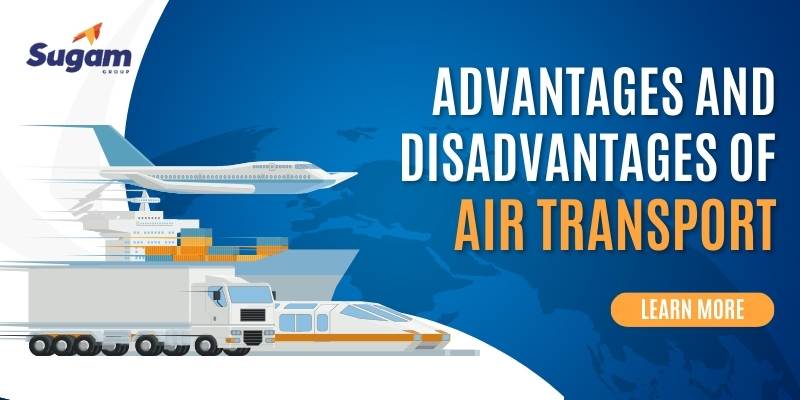Advantages and Disadvantages of Air Transportation
Transportation is the lifeblood of our modern world, enabling the movement of people and goods across vast distances. In this blog, we’ll delve into one of the most remarkable modes of transportation: air transport. We’ll explore its characteristics, advantages, and disadvantages, and we’ll also discuss scenarios in which air transport is the best option.
What is Air Transport?
Air transport, simply put, is the movement of people, goods, or cargo through the use of aircraft. This mode of transportation has revolutionized the way we connect globally, shrinking the world and making it more accessible than ever before. From commercial airliners to cargo planes, helicopters to private jets, air transport encompasses a diverse range of aircraft.
Contact Us For Freight Transportation
Characteristics of Air Transport
Speed: One of the most remarkable features of air transport is its speed. Aircraft can travel at significantly higher speeds compared to other modes of transportation, allowing people and goods to reach their destinations quickly.
Accessibility: Air transport has the unique advantage of reaching remote and inaccessible areas, such as islands, mountainous regions, and disaster-stricken zones. This accessibility can be crucial for medical emergencies, relief efforts, and remote business operations.
Reliability: Air transport is known for its high level of schedule adherence and reliability. Airlines adhere to strict timetables, minimising delays and ensuring passengers and cargo reach their destinations on time.
Cost: While air transport offers numerous advantages, it can be relatively expensive compared to other modes. The cost of operating and maintaining aircraft, along with security and safety measures, contributes to higher ticket prices and cargo fees.
Read More:- Advantages And Disadvantages Of Water Transportation
Advantages of Air Transportation
Speed and Efficiency: Air transport is unbeatable when it comes to speed. Passengers can traverse continents in a matter of hours, and goods can be delivered to international destinations in a fraction of the time it would take by sea or land.
Global Connectivity: Air transport links the world, connecting cities and countries across the globe. It facilitates international trade, tourism, and cultural exchange, making the world a smaller and more interconnected place.
Safety: Air travel is considered one of the safest modes of Freight transportation. Stringent regulations, rigorous training for pilots and crew, and advanced technology contribute to a high level of safety for passengers and cargo.
Convenience: Booking a flight has never been easier. With the advent of online booking platforms and digital check-ins, air travel offers unmatched convenience. Modern airports provide amenities that enhance the travel experience, from lounges to efficient security processes.
Rapid Speed: Air transport stands out for its ability to cover extensive distances in remarkably short timeframes. This makes it the optimal choice when there’s an urgent need to transport goods or when freight requires special handling or quick delivery. It is the fastest mode of transportation, significantly reducing transit times.
Swift Service: Air transportation provides convenient, dependable, and swift freight services. It is often considered the most efficient method for shipping goods over long distances, delivering a consistent and expedited service.
Unobstructed Routes: Aircraft can traverse virtually any location without encountering natural obstacles or geographical barriers. This ease of access facilitates streamlined customs procedures, eliminating the need for lengthy clearance processes. Additionally, air travel plays a crucial role in relief operations during disasters such as earthquakes, floods, accidents, and famines.
Disadvantages of Air Transportation
Air transport offers undeniable advantages in terms of speed and convenience, allowing people and goods to travel vast distances in a matter of hours. However, it also comes with its share of disadvantages that should be considered.
Cost: Perhaps the most significant drawback of air transport is its cost. Airline tickets, especially for long-haul flights, can be expensive. The high operational expenses associated with aircraft maintenance, fuel, and security measures are passed on to passengers and shippers.
Environmental Impact: The environmental impact of air travel, particularly in terms of carbon emissions, is a concern. Aircraft emit greenhouse gases, contributing to climate change. Efforts are being made to develop more fuel-efficient and eco-friendly aircraft, but this remains a challenge.
Weather Dependency: Air transport is highly weather-dependent. Adverse weather conditions, such as storms, fog, or volcanic eruptions, can lead to flight delays and cancellations. Passengers and shippers must be prepared for these disruptions.
Limited Cargo Capacity: While air transport is incredibly fast, it has limitations in terms of cargo volume. Cargo planes have limited space compared to ships, making them less suitable for transporting large quantities of goods.
Read More:- Intermodal Transportation
In Which Cases is Air Transport the Best Option?
Time-Sensitive Shipments: When time is of the essence, air transport is the go-to choice. Critical medical supplies, perishable goods, and urgent documents can be delivered quickly via air. In emergency situations, every minute counts.
Long-Distance Travel: For long-distance travel, especially international journeys, air transport is the most efficient option. It saves passengers from enduring exhausting multi-day journeys by land or sea.
Emergency Situations: Air transport plays a pivotal role in emergency situations and disaster relief efforts. Whether it’s delivering aid to earthquake-stricken regions or airlifting patients to specialised medical facilities, aircraft provide a lifeline during crises.
Conclusion
In conclusion, air transport has reshaped the way we connect and conduct business on a global scale. Its speed, accessibility, and reliability have made it an indispensable mode of transportation. However, it’s essential to consider the disadvantages, including cost and environmental concerns.
The key to choosing the right mode of transportation lies in assessing your specific needs and circumstances. For time-sensitive shipments and long-distance travel, air transport shines. In emergencies, it can be a lifesaver. As technology continues to advance, addressing environmental challenges and enhancing efficiency, air transport will remain a vital component of our interconnected world, albeit one that requires thoughtful consideration and responsible usage.




No Comments